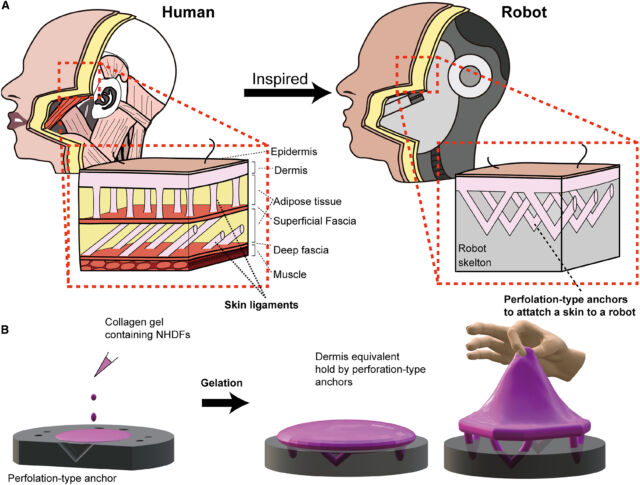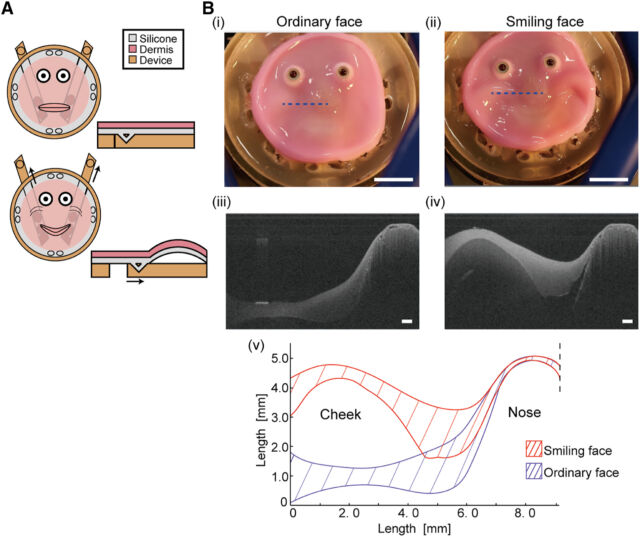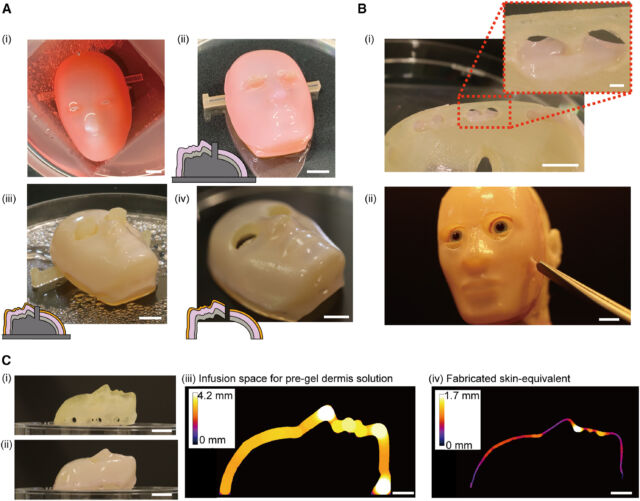CREEPY
Scientists create humanoid robot with ‘living’ skin that can smileWATCH
Scientists create humanoid robot with ‘living’ skin
Takeuchi explained how he and his team succeeded in creating a humanoid robot with “living” skin by drawing inspiration from his previous experiments. “During previous research on a finger-shaped robot covered in engineered skin tissue we grew in our lab, I felt the need for better adhesion between the robotic features and the subcutaneous structure of the skin,” he said.
“By mimicking human skin-ligament structures and by using specially made V-shaped perforations in solid materials, we found a way to bind skin to complex structures. The natural flexibility of the skin and the strong method of adhesion mean the skin can move with the mechanical components of the robot without tearing or peeling away,” Takeuchi continued.
“In this study, we managed to replicate human appearance to some extent by creating a face with the same surface material and structure as humans,” said Takeuchi, who holds expertise in the field of biohybrid robotics, where biology and mechanical engineering meet.
“Additionally, through this research, we identified new challenges, such as the necessity for surface wrinkles and a thicker epidermis to achieve a more humanlike appearance.” “We believe that creating a thicker and more realistic skin can be achieved by incorporating sweat glands, sebaceous glands, pores, blood vessels, fat and nerves.”
“Of course, movement is also a crucial factor, not just the material, so another important challenge is creating humanlike expressions by integrating sophisticated actuators, or muscles, inside the robot,” he explained. “Creating robots that can heal themselves, sense their environment more accurately and perform tasks with humanlike dexterity is incredibly motivating.”
ByArya Vaishnavi
Jun 30, 2024
“By mimicking human skin-ligament structures, we found a way to bind skin to complex structures,” Professor Shoji Takeuchi said
Japanese researchers have created an alien-like robot with “living” skin. What looks like a pink blob with beady eyes is actually a humanoid robot bound with engineered skin tissue that allows it to smile. The University of Tokyo announced the successful experiment by Professor Shoji Takeuchi-led group of researchers on Wednesday, June 26.
Jun 30, 2024
“By mimicking human skin-ligament structures, we found a way to bind skin to complex structures,” Professor Shoji Takeuchi said
Japanese researchers have created an alien-like robot with “living” skin. What looks like a pink blob with beady eyes is actually a humanoid robot bound with engineered skin tissue that allows it to smile. The University of Tokyo announced the successful experiment by Professor Shoji Takeuchi-led group of researchers on Wednesday, June 26.

A group of Japanese researchers have created a humanoid robot with 'living' skin(The University of Tokyo)
Scientists create humanoid robot with ‘living’ skin
Takeuchi explained how he and his team succeeded in creating a humanoid robot with “living” skin by drawing inspiration from his previous experiments. “During previous research on a finger-shaped robot covered in engineered skin tissue we grew in our lab, I felt the need for better adhesion between the robotic features and the subcutaneous structure of the skin,” he said.
“By mimicking human skin-ligament structures and by using specially made V-shaped perforations in solid materials, we found a way to bind skin to complex structures. The natural flexibility of the skin and the strong method of adhesion mean the skin can move with the mechanical components of the robot without tearing or peeling away,” Takeuchi continued.
“In this study, we managed to replicate human appearance to some extent by creating a face with the same surface material and structure as humans,” said Takeuchi, who holds expertise in the field of biohybrid robotics, where biology and mechanical engineering meet.
“Additionally, through this research, we identified new challenges, such as the necessity for surface wrinkles and a thicker epidermis to achieve a more humanlike appearance.” “We believe that creating a thicker and more realistic skin can be achieved by incorporating sweat glands, sebaceous glands, pores, blood vessels, fat and nerves.”
“Of course, movement is also a crucial factor, not just the material, so another important challenge is creating humanlike expressions by integrating sophisticated actuators, or muscles, inside the robot,” he explained. “Creating robots that can heal themselves, sense their environment more accurately and perform tasks with humanlike dexterity is incredibly motivating.”
I'VE SEEN THINGS YOU PEOPLE WOULDN'T BELIEVE —
Researchers craft smiling robot face from living human skin cells
Researchers craft smiling robot face from living human skin cells
Human cells isolated from juvenile foreskin are flexible enough to grin when moved.
BENJ EDWARDS - 6/28/2024,

Enlarge / A movable robotic face covered with living human skin cells.
Takeuchi et al.178
In a new study, researchers from the University of Tokyo, Harvard University, and the International Research Center for Neurointelligence have unveiled a technique for creating lifelike robotic skin using living human cells. As a proof of concept, the team engineered a small robotic face capable of smiling, covered entirely with a layer of pink living tissue.
FURTHER READINGHuman cells hacked to act like squid skin cells could unlock key to camouflage
The researchers note that using living skin tissue as a robot covering has benefits, as it's flexible enough to convey emotions and can potentially repair itself. "As the role of robots continues to evolve, the materials used to cover social robots need to exhibit lifelike functions, such as self-healing," wrote the researchers in the study.
Shoji Takeuchi, Michio Kawai, Minghao Nie, and Haruka Oda authored the study, titled "Perforation-type anchors inspired by skin ligament for robotic face covered with living skin," which is due for July publication in Cell Reports Physical Science. We learned of the study from a report published earlier this week by New Scientist.
The study describes a novel method for attaching cultured skin to robotic surfaces using "perforation-type anchors" inspired by natural skin ligaments. These tiny v-shaped cavities in the robot's structure allow living tissue to infiltrate and create a secure bond, mimicking how human skin attaches to underlying tissues.
To demonstrate the skin's capabilities, the team engineered a palm-sized robotic face able to form a convincing smile. Actuators connected to the base allowed the face to move, with the living skin flexing. The researchers also covered a static 3D-printed head shape with the engineered skin

Enlarge / "Conceptual illustration of the tissue-fixation method using perforation-type anchor."
Takeuchi et al.
After obtaining the cells, the researchers then cultured them in specialized growth media to create the living skin layer. To keep the skin cells alive, the researchers used a special growth media supplemented with some antibiotics to keep bacteria at bay. The paper states that "Fibroblast growth medium (DMEM supplemented with 10% FBS, 1% penicillin-streptomycin, and 70 mg/mL L-ascorbic acid phosphate magnesium salt n-hydrate)" was used for the dermal fibroblasts. For the epidermal keratinocytes, the researchers used "keratinocyte growth medium (Keratinocyte Growth Medium 3 Kit supplemented with 1% penicillin-streptomycin)."
The researchers also note that "for both NHDFs and NHEKs, media were refurbished once every 2 days." This regular refreshing of the growth media provided the necessary nutrients to keep the cells alive during the experiment.
Potentially useful for testing
While ethical questions inevitably arise from using real human skin cells, the researchers state that their goal is to improve human-robot communication and advance tissue engineering. They hope their techniques will find applications not just in robotics but in fields like reconstructive medicine and drug testing. Instead of using real human test subjects, experimenters could grow artificial skin layers from real cells.
FURTHER READINGTesla unveils its latest humanoid robot, Optimus Gen 2, in demo video
Beyond improving robotic interfaces, the research team believes their technique could have applications in cosmetics testing. By repeatedly actuating their smiling robot face over time, they observed the formation of expression lines analogous to human wrinkles.
The paper notes: "One significant next step in this research is to leverage this model to enhance our understanding of the mechanisms underlying wrinkle formation. Moreover, applying this knowledge to recreate such expressions on a chip could find applications in the cosmetics industry and the orthopedic surgery industry."

Enlarge / "The smiling robotic face covered with dermis equivalent demonstrating actuation of the dermis equivalent via the perforation-type anchors."
Takeuchi et al.
However, the researchers caution that significant hurdles remain before the technology can be applied to full-scale humanoid robots. The engineered skin currently lacks sensory capabilities and requires constant nutrient supply, limiting its lifespan in open air. To address these issues, the researchers hope to incorporate new mechanisms that will help the skin survive over longer periods of time.
With continued refinement, living robotic skin could create machine coverings that are not just lifelike but literally alive. Eventually, they may even live long enough to see attack ships on fire off the shoulder of Orion. Or watch C-beams glitter in the dark near the Tannhäuser Gate. But we're hoping those moments will not be lost in time—like tears in rain.
BENJ EDWARDSBenj Edwards is Ars Technica's Senior AI Reporter. In his free time, he writes and records music, collects vintage computers, and enjoys nature. He lives in Raleigh, NC.
BENJ EDWARDS - 6/28/2024,

Enlarge / A movable robotic face covered with living human skin cells.
Takeuchi et al.178
In a new study, researchers from the University of Tokyo, Harvard University, and the International Research Center for Neurointelligence have unveiled a technique for creating lifelike robotic skin using living human cells. As a proof of concept, the team engineered a small robotic face capable of smiling, covered entirely with a layer of pink living tissue.
FURTHER READINGHuman cells hacked to act like squid skin cells could unlock key to camouflage
The researchers note that using living skin tissue as a robot covering has benefits, as it's flexible enough to convey emotions and can potentially repair itself. "As the role of robots continues to evolve, the materials used to cover social robots need to exhibit lifelike functions, such as self-healing," wrote the researchers in the study.
Shoji Takeuchi, Michio Kawai, Minghao Nie, and Haruka Oda authored the study, titled "Perforation-type anchors inspired by skin ligament for robotic face covered with living skin," which is due for July publication in Cell Reports Physical Science. We learned of the study from a report published earlier this week by New Scientist.
The study describes a novel method for attaching cultured skin to robotic surfaces using "perforation-type anchors" inspired by natural skin ligaments. These tiny v-shaped cavities in the robot's structure allow living tissue to infiltrate and create a secure bond, mimicking how human skin attaches to underlying tissues.
To demonstrate the skin's capabilities, the team engineered a palm-sized robotic face able to form a convincing smile. Actuators connected to the base allowed the face to move, with the living skin flexing. The researchers also covered a static 3D-printed head shape with the engineered skin
.
Enlarge / "Demonstration of the perforation-type anchors to cover the facial device with skin equivalent."
Takeuchi et al.
Takeuchi et al. created their robotic face by first 3D-printing a resin base embedded with the perforation-type anchors. They then applied a mixture of human skin cells in a collagen scaffold, allowing the living tissue to grow into the anchors.
Real human skin cells
So whose skin did the researchers use? As it turns out, living human skin cells are readily available for purchase, and the cells came from a large number of anonymous human donors.
In their experiments, the researchers used commercially available human cells, purchasing what are called Normal Human Dermal Fibroblasts (NHDFs) and Normal Human Epidermal Keratinocytes (NHEKs) that were isolated from either juvenile foreskin or different skin locations from adult donors by a company called PromoCell GmbH.
A fibroblast is a special type of structural cell that contributes to the formation of connective tissue. And Keratinocytes represent "the major cell type of the epidermis, the outermost of the layers of the skin, making up about 90 percent of the cells there," according to PromoCell's website.

Enlarge / "Demonstration of the perforation-type anchors to cover the facial device with skin equivalent."
Takeuchi et al.
Takeuchi et al. created their robotic face by first 3D-printing a resin base embedded with the perforation-type anchors. They then applied a mixture of human skin cells in a collagen scaffold, allowing the living tissue to grow into the anchors.
Real human skin cells
So whose skin did the researchers use? As it turns out, living human skin cells are readily available for purchase, and the cells came from a large number of anonymous human donors.
In their experiments, the researchers used commercially available human cells, purchasing what are called Normal Human Dermal Fibroblasts (NHDFs) and Normal Human Epidermal Keratinocytes (NHEKs) that were isolated from either juvenile foreskin or different skin locations from adult donors by a company called PromoCell GmbH.
A fibroblast is a special type of structural cell that contributes to the formation of connective tissue. And Keratinocytes represent "the major cell type of the epidermis, the outermost of the layers of the skin, making up about 90 percent of the cells there," according to PromoCell's website.

Enlarge / "Conceptual illustration of the tissue-fixation method using perforation-type anchor."
Takeuchi et al.
After obtaining the cells, the researchers then cultured them in specialized growth media to create the living skin layer. To keep the skin cells alive, the researchers used a special growth media supplemented with some antibiotics to keep bacteria at bay. The paper states that "Fibroblast growth medium (DMEM supplemented with 10% FBS, 1% penicillin-streptomycin, and 70 mg/mL L-ascorbic acid phosphate magnesium salt n-hydrate)" was used for the dermal fibroblasts. For the epidermal keratinocytes, the researchers used "keratinocyte growth medium (Keratinocyte Growth Medium 3 Kit supplemented with 1% penicillin-streptomycin)."
The researchers also note that "for both NHDFs and NHEKs, media were refurbished once every 2 days." This regular refreshing of the growth media provided the necessary nutrients to keep the cells alive during the experiment.
Potentially useful for testing
While ethical questions inevitably arise from using real human skin cells, the researchers state that their goal is to improve human-robot communication and advance tissue engineering. They hope their techniques will find applications not just in robotics but in fields like reconstructive medicine and drug testing. Instead of using real human test subjects, experimenters could grow artificial skin layers from real cells.
FURTHER READINGTesla unveils its latest humanoid robot, Optimus Gen 2, in demo video
Beyond improving robotic interfaces, the research team believes their technique could have applications in cosmetics testing. By repeatedly actuating their smiling robot face over time, they observed the formation of expression lines analogous to human wrinkles.
The paper notes: "One significant next step in this research is to leverage this model to enhance our understanding of the mechanisms underlying wrinkle formation. Moreover, applying this knowledge to recreate such expressions on a chip could find applications in the cosmetics industry and the orthopedic surgery industry."

Enlarge / "The smiling robotic face covered with dermis equivalent demonstrating actuation of the dermis equivalent via the perforation-type anchors."
Takeuchi et al.
However, the researchers caution that significant hurdles remain before the technology can be applied to full-scale humanoid robots. The engineered skin currently lacks sensory capabilities and requires constant nutrient supply, limiting its lifespan in open air. To address these issues, the researchers hope to incorporate new mechanisms that will help the skin survive over longer periods of time.
With continued refinement, living robotic skin could create machine coverings that are not just lifelike but literally alive. Eventually, they may even live long enough to see attack ships on fire off the shoulder of Orion. Or watch C-beams glitter in the dark near the Tannhäuser Gate. But we're hoping those moments will not be lost in time—like tears in rain.
BENJ EDWARDSBenj Edwards is Ars Technica's Senior AI Reporter. In his free time, he writes and records music, collects vintage computers, and enjoys nature. He lives in Raleigh, NC.
No comments:
Post a Comment